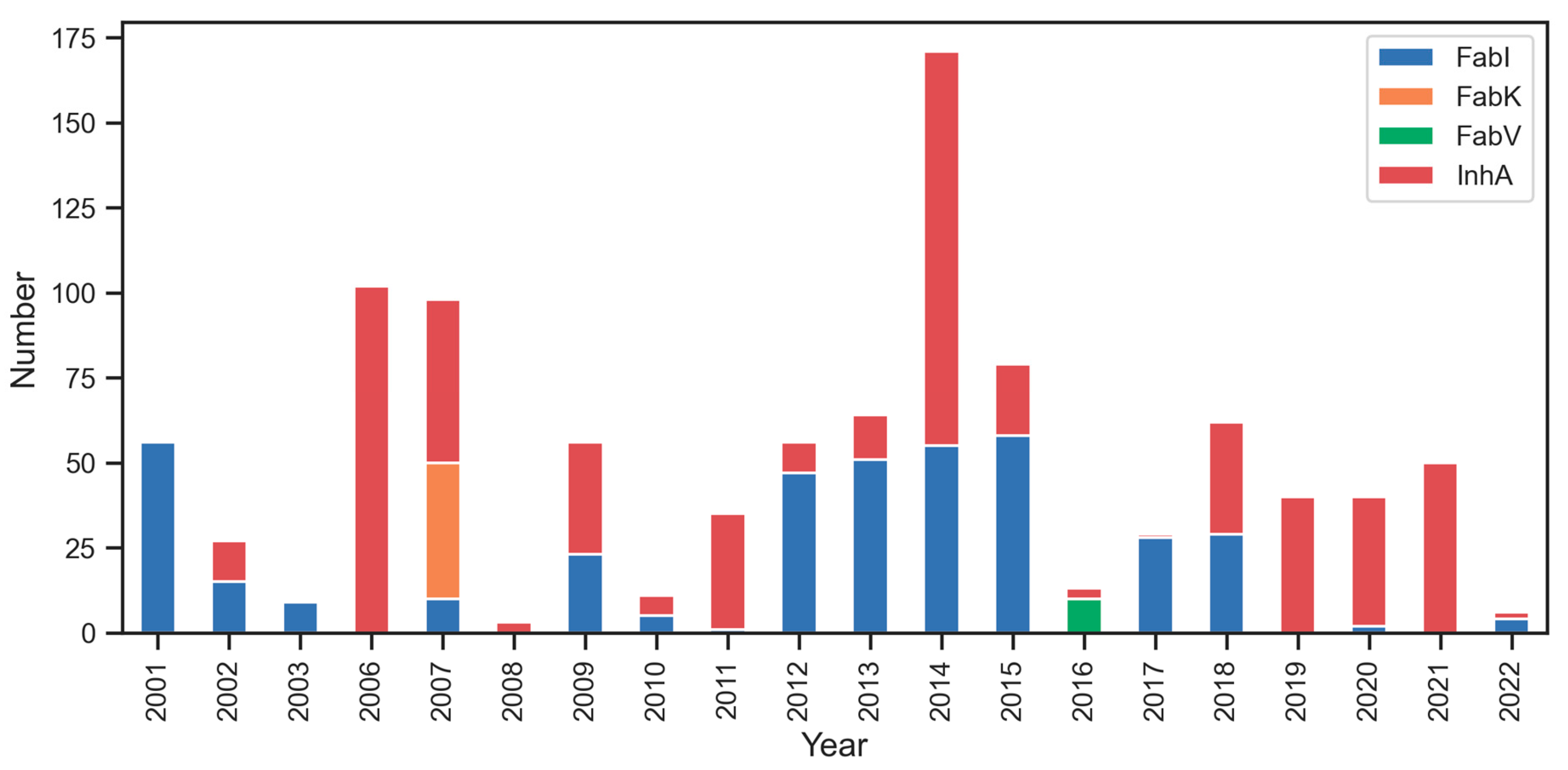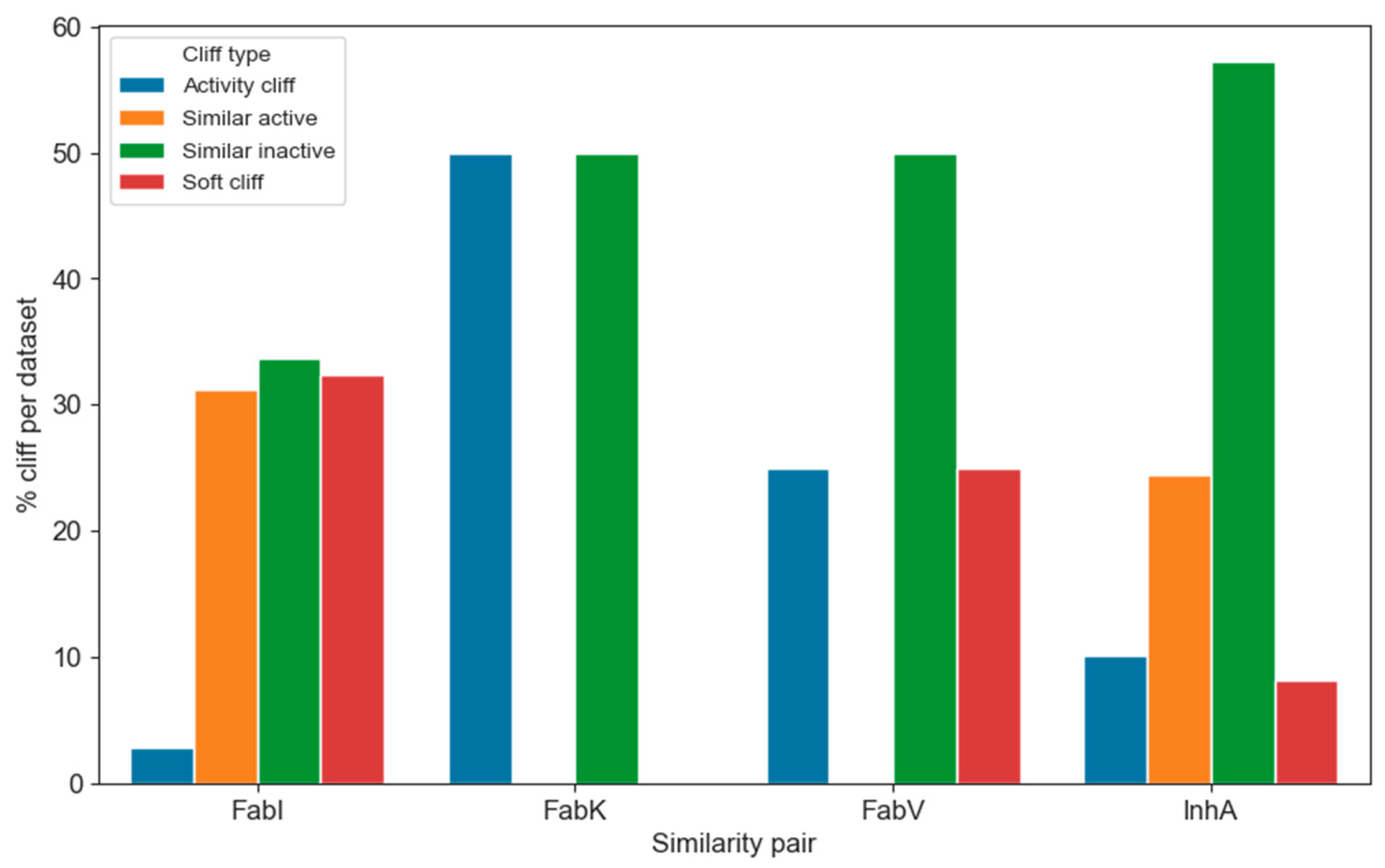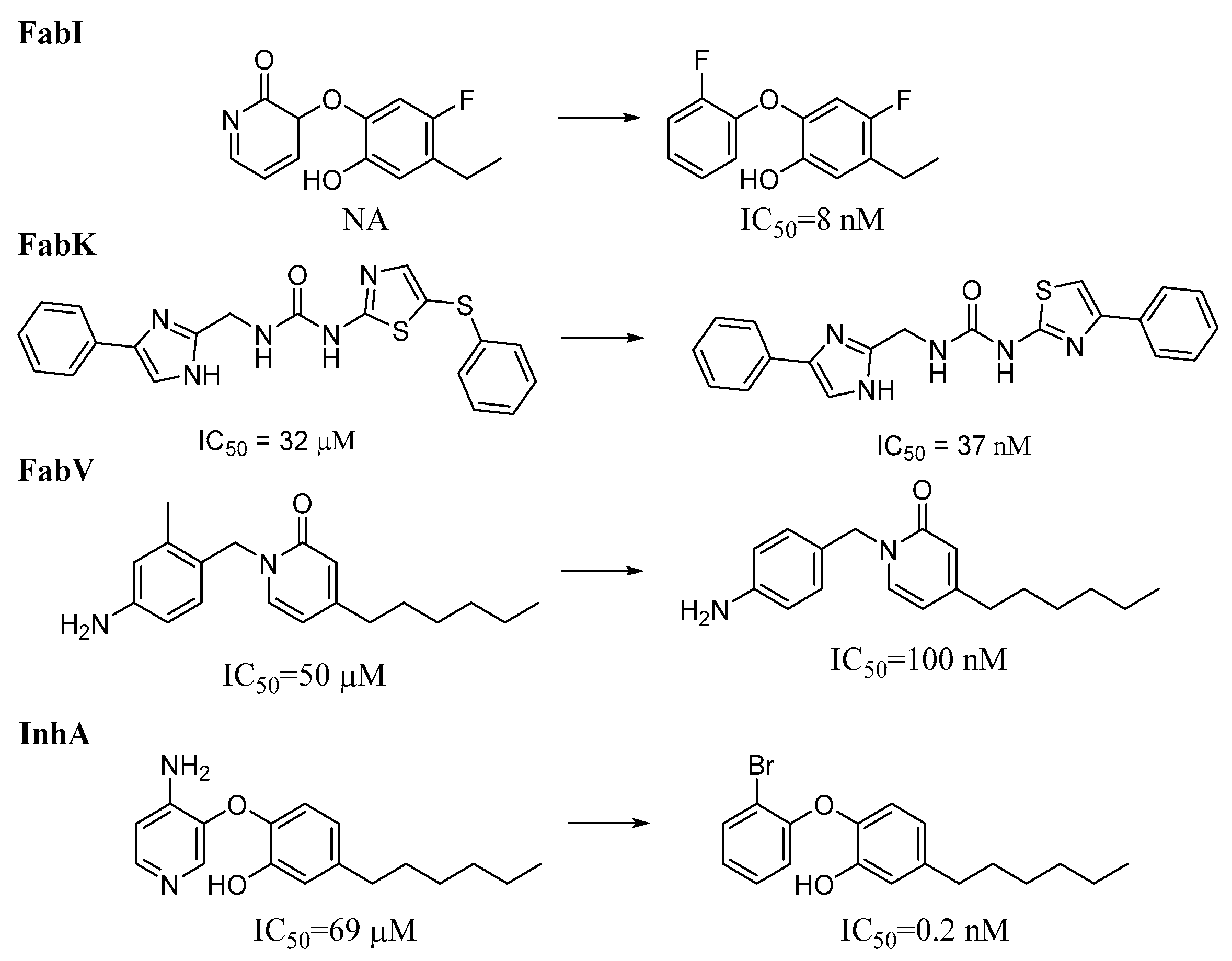Navigating the Chemical Space of ENR Inhibitors: A Comprehensive Analysis
Abstract
1. Introduction
2. Results and Discussion
2.1. Data Collection, Preprocessing, and Classification
2.2. Physicochemical Properties
2.3. Lipinski’s Rule of Five
2.4. PAINS and Brenk Filters
2.5. Structural Diversity
2.5.1. Chemotype Diversity
2.5.2. Molecular Similarity
2.5.3. t-SNE Analysis
2.5.4. Complexity of Datasets
2.5.5. Analysis of Clusters
2.6. Matched Molecular Pairs (MMP)
- Activity cliff—At least one of the compounds in the MMP is active and the difference in activity is at least 100 nM.
- Soft cliff—At least one of the compounds in the MMP is active and the difference in activity is less than 100 nM.
- Similarly active—Both compounds in the MMP are active and the difference in activity is less than 100 nM.
- Similarly inactive—Both compounds in the MMP are inactive and the difference in activity is less than 100 nM.
2.7. SHAP Analysis
3. Materials and Methods
3.1. Data Collection, Preprocessing, and Classification
3.2. Calculation of Molecular Descriptors
3.3. Lipinski’s Rule of Five, PAINS, and Brenk
3.4. Normal Distribution Testing
3.5. Mann–Whitney U Rank Test
3.6. Visualization Using t-SNE Analysis
3.7. Visualization Using t-SNE Analysis
3.8. Clustering Analysis
3.8.1. Maximum Common Substructure (MCS)
3.8.2. Analysis of Scaffolds
3.9. Diversity of Chemotypes
3.10. Molecule Similarity
3.11. SHAP Analysis
3.12. Matched Molecular Pairs (MMP)
4. Conclusions
Supplementary Materials
Author Contributions
Funding
Institutional Review Board Statement
Informed Consent Statement
Data Availability Statement
Conflicts of Interest
References
- CDCTB Tuberculosis (TB)—Drug-Resistant TB. Available online: https://www.cdc.gov/tb/topic/drtb/default.htm (accessed on 19 January 2024).
- Rana, P.; Ghouse, S.M.; Akunuri, R.; Madhavi, Y.V.; Chopra, S.; Nanduri, S. FabI (Enoyl Acyl Carrier Protein Reductase)—A Potential Broad Spectrum Therapeutic Target and Its Inhibitors. Eur. J. Med. Chem. 2020, 208, 112757. [Google Scholar] [CrossRef] [PubMed]
- Brinster, S.; Lamberet, G.; Staels, B.; Trieu-Cuot, P.; Gruss, A.; Poyart, C. Type II Fatty Acid Synthesis Is Not a Suitable Antibiotic Target for Gram-Positive Pathogens. Nature 2009, 458, 83–86. [Google Scholar] [CrossRef] [PubMed]
- Kumar, K.; Chopra, S. New Drugs for Methicillin-Resistant Staphylococcus Aureus: An Update. J. Antimicrob. Chemother. 2013, 68, 1465–1470. [Google Scholar] [CrossRef] [PubMed]
- Wickramasinghe, S.R.; Inglis, K.A.; Urch, J.E.; Müller, S.; van Aalten, D.M.F.; Fairlamb, A.H. Kinetic, Inhibition and Structural Studies on 3-Oxoacyl-ACP Reductase from Plasmodium falciparum, a Key Enzyme in Fatty Acid Biosynthesis. Biochem. J. 2006, 393, 447–457. [Google Scholar] [CrossRef] [PubMed]
- Zitko, J.; Dolezal, M. Enoyl Acyl Carrier Protein Reductase Inhibitors: An Updated Patent Review (2011–2015). Expert Opin. Ther. Pat. 2016, 26, 1079–1094. [Google Scholar] [CrossRef] [PubMed]
- Massengo-Tiassé, R.P.; Cronan, J.E. Diversity in Enoyl-Acyl Carrier Protein Reductases. Cell. Mol. Life Sci. 2009, 66, 1507–1517. [Google Scholar] [CrossRef] [PubMed]
- Zheng, C.J.; Sohn, M.-J.; Kim, W.-G. Vinaxanthone, a New FabI Inhibitor from Penicillium sp. J. Antimicrob. Chemother. 2009, 63, 949–953. [Google Scholar] [CrossRef] [PubMed]
- Parikh, S.; Xiao, G.; Tonge, P. Inhibition of InhA, the Enoyl Reductase from Mycobacterium tuberculosis, by Triclosan and Isoniazid. Biochemistry 2000, 39, 7645–7650. [Google Scholar] [CrossRef]
- Rožman, K.; Sosič, I.; Fernandez, R.; Young, R.J.; Mendoza, A.; Gobec, S.; Encinas, L. A New ‘Golden Age’ for the Antitubercular Target InhA. Drug Discov. Today 2017, 22, 492–502. [Google Scholar] [CrossRef]
- Holas, O.; Ondrejcek, P.; Dolezal, M. Mycobacterium tuberculosis Enoyl-Acyl Carrier Protein Reductase Inhibitors as Potential Antituberculotics: Development in the Past Decade. J. Enzyme Inhib. Med. Chem. 2015, 30, 629–648. [Google Scholar] [CrossRef]
- Singh, I.; Juneja, P.; Kaur, B.; Kumar, P. Pharmaceutical Applications of Chemometric Techniques. Int. Sch. Res. Notice 2013, 2013, e795178. [Google Scholar] [CrossRef]
- Mocák, J.J. Chemometrics in Medicine and Pharmacy. Nova Biotechnol. Chim. 2012, 11, 11–26. [Google Scholar] [CrossRef]
- Cocchi, M.; Vigni, M.L.; Durante, C. Chemometrics—Bioinformatics. In Food Authentication; John Wiley & Sons, Ltd.: Hoboken, NJ, USA, 2017; pp. 481–518. ISBN 978-1-118-81022-4. [Google Scholar]
- Oprea, T.I.; Gottfries, J. Chemography: The Art of Navigating in Chemical Space. J. Comb. Chem. 2001, 3, 157–166. [Google Scholar] [CrossRef] [PubMed]
- Xia, X. Bioinformatics and Drug Discovery. Curr. Top. Med. Chem. 2017, 17, 1709–1726. [Google Scholar] [CrossRef] [PubMed]
- Anuwongcharoen, N.; Shoombuatong, W.; Tantimongcolwat, T.; Prachayasittikul, V.; Nantasenamat, C. Exploring the Chemical Space of Influenza Neuraminidase Inhibitors. PeerJ 2016, 4, e1958. [Google Scholar] [CrossRef] [PubMed]
- Czub, N.; Pacławski, A.; Szlęk, J.; Mendyk, A. Do AutoML-Based QSAR Models Fulfill OECD Principles for Regulatory Assessment? A 5-HT1A Receptor Case. Pharmaceutics 2022, 14, 1415. [Google Scholar] [CrossRef] [PubMed]
- Aniceto, N.; Bonifácio, V.D.B.; Guedes, R.C.; Martinho, N. Exploring the Chemical Space of Urease Inhibitors to Extract Meaningful Trends and Drivers of Activity. J. Chem. Inf. Model. 2022, 62, 3535–3550. [Google Scholar] [CrossRef]
- Victoria-Muñoz, F.; Sánchez-Cruz, N.; Medina-Franco, J.L.; Lopez-Vallejo, F. Cheminformatics Analysis of Molecular Datasets of Transcription Factors Associated with Quorum Sensing in Pseudomonas aeruginosa. RSC Adv. 2022, 12, 6783–6790. [Google Scholar] [CrossRef]
- Landrum, G. RDKit: Open-Source Cheminformatics; 2006. [Google Scholar] [CrossRef]
- Meanwell, N.A. Improving Drug Design: An Update on Recent Applications of Efficiency Metrics, Strategies for Replacing Problematic Elements, and Compounds in Nontraditional Drug Space. Chem. Res. Toxicol. 2016, 29, 564–616. [Google Scholar] [CrossRef]
- Lipinski, C.A. Drug-like Properties and the Causes of Poor Solubility and Poor Permeability. J. Pharmacol. Toxicol. Methods 2000, 44, 235–249. [Google Scholar] [CrossRef]
- Lipinski, C.A.; Lombardo, F.; Dominy, B.W.; Feeney, P.J. Experimental and Computational Approaches to Estimate Solubility and Permeability in Drug Discovery and Development Settings. Adv. Drug Deliv. Rev. 1997, 23, 3–25. [Google Scholar] [CrossRef]
- Liu, R.; Tsong, Y. (Eds.) Pharmaceutical Statistics: MBSW 39, Muncie, IN, USA, 16–18 May 2016; Springer: Cham, Switzerland, 2016. [Google Scholar]
- Zhang, M.-Q.; Wilkinson, B. Drug Discovery beyond the “Rule-of-Five”. Curr. Opin. Biotechnol. 2007, 18, 478–488. [Google Scholar] [CrossRef] [PubMed]
- O’Shea, R.; Moser, H.E. Physicochemical Properties of Antibacterial Compounds: Implications for Drug Discovery. J. Med. Chem. 2008, 51, 2871–2878. [Google Scholar] [CrossRef] [PubMed]
- Neidle, S. Design Principles for Quadruplex-Binding Small Molecules. In Therapeutic Applications of Quadruplex Nucleic Acids; Elsevier: Amsterdam, The Netherlands, 2012; pp. 151–174. ISBN 978-0-12-375138-6. [Google Scholar]
- Baell, J.B.; Nissink, J.W.M. Seven Year Itch: Pan-Assay Interference Compounds (PAINS) in 2017—Utility and Limitations. ACS Chem. Biol. 2018, 13, 36–44. [Google Scholar] [CrossRef] [PubMed]
- Capuzzi, S.J.; Muratov, E.N.; Tropsha, A. Phantom PAINS: Problems with the Utility of Alerts for Pan-Assay INterference CompoundS. J. Chem. Inf. Model. 2017, 57, 417–427. [Google Scholar] [CrossRef] [PubMed]
- Brenk, R.; Schipani, A.; James, D.; Krasowski, A.; Gilbert, I.H.; Frearson, J.; Wyatt, P.G. Lessons Learnt from Assembling Screening Libraries for Drug Discovery for Neglected Diseases. ChemMedChem 2008, 3, 435–444. [Google Scholar] [CrossRef] [PubMed]
- Brown, N. Bioisosteres and Scaffold Hopping in Medicinal Chemistry. Mol. Inform. 2014, 33, 458–462. [Google Scholar] [CrossRef]
- Bemis, G.W.; Murcko, M.A. The Properties of Known Drugs. 1. Molecular Frameworks. J. Med. Chem. 1996, 39, 2887–2893. [Google Scholar] [CrossRef]
- González-Medina, M.; Prieto-Martínez, F.D.; Owen, J.R.; Medina-Franco, J.L. Consensus Diversity Plots: A Global Diversity Analysis of Chemical Libraries. J. Cheminform. 2016, 8, 63. [Google Scholar] [CrossRef]
- Lovering, F.; Bikker, J.; Humblet, C. Escape from Flatland: Increasing Saturation as an Approach to Improving Clinical Success. J. Med. Chem. 2009, 52, 6752–6756. [Google Scholar] [CrossRef]
- Méndez-Lucio, O.; Medina-Franco, J.L. The Many Roles of Molecular Complexity in Drug Discovery. Drug Discov. Today 2017, 22, 120–126. [Google Scholar] [CrossRef] [PubMed]
- Chen, T.; Shu, X.; Zhou, H.; Beckford, F.A.; Misir, M. Algorithm Selection for Protein–Ligand Docking: Strategies and Analysis on ACE. Sci. Rep. 2023, 13, 8219. [Google Scholar] [CrossRef] [PubMed]
- Curatolo, W. Physical Chemical Properties of Oral Drug Candidates in the Discovery and Exploratory Development Settings. Pharm. Sci. Technol. Today 1998, 1, 387–393. [Google Scholar] [CrossRef]
- Sivaraman, S.; Sullivan, T.J.; Johnson, F.; Novichenok, P.; Cui, G.; Simmerling, C.; Tonge, P.J. Inhibition of the Bacterial Enoyl Reductase FabI by Triclosan: A Structure-Reactivity Analysis of FabI Inhibition by Triclosan Analogues. J. Med. Chem. 2004, 47, 509–518. [Google Scholar] [CrossRef] [PubMed]
- Armstrong, T.; Lamont, M.; Lanne, A.; Alderwick, L.J.; Thomas, N.R. Inhibition of Mycobacterium tuberculosis InhA: Design, Synthesis and Evaluation of New Di-Triclosan Derivatives. Bioorg. Med. Chem. 2020, 28, 115744. [Google Scholar] [CrossRef] [PubMed]
- Wassermann, A.M.; Bajorath, J. Chemical Substitutions That Introduce Activity Cliffs Across Different Compound Classes and Biological Targets. J. Chem. Inf. Model. 2010, 50, 1248–1256. [Google Scholar] [CrossRef] [PubMed]
- Sushko, Y.; Novotarskyi, S.; Körner, R.; Vogt, J.; Abdelaziz, A.; Tetko, I.V. Prediction-Driven Matched Molecular Pairs to Interpret QSARs and Aid the Molecular Optimization Process. J. Cheminform. 2014, 6, 48. [Google Scholar] [CrossRef]
- He, Y.; Liew, C.Y.; Sharma, N.; Woo, S.K.; Chau, Y.T.; Yap, C.W. PaDEL-DDPredictor: Open-source Software for PD-PK-T Prediction. J. Comput. Chem. 2013, 34, 604–610. [Google Scholar] [CrossRef]
- Chollet, A.; Maveyraud, L.; Lherbet, C.; Bernardes-Genisson, V. An Overview on Crystal Structures of InhA Protein: Apo-Form, in Complex with Its Natural Ligands and Inhibitors. Eur. J. Med. Chem. 2018, 146, 318–343. [Google Scholar] [CrossRef]
- Pan, P.; Tonge, P.J. Targeting InhA, the FASII Enoyl-ACP Reductase: SAR Studies on Novel Inhibitor Scaffolds. Curr. Top. Med. Chem. 2012, 12, 672–693. [Google Scholar] [CrossRef]
- Sullivan, T.; am Ende, C.; Truglio, J.; Johnson, F.; Lenaerts, A.; Slayden, R.; Kisker, C.; Tonge, P. High Affinity InhA Inhibitors with Activity against Drug-Resistant Strains of Mycobacterium tuberculosis. ACS Chem. Biol. 2006, 1, 43–53. [Google Scholar] [CrossRef] [PubMed]
- Hussain, J.; Rea, C. Computationally Efficient Algorithm to Identify Matched Molecular Pairs (MMPs) in Large Datasets. J. Chem. Inf. Model. 2010, 50, 339–348. [Google Scholar] [CrossRef] [PubMed]
- He, X.; Alian, A.; Stroud, R.; Ortiz de Montellano, P.R. Pyrrolidine Carboxamides as a Novel Class of Inhibitors of Enoyl Acyl Carrier Protein Reductase from Mycobacterium tuberculosis. J. Med. Chem. 2006, 49, 6308–6323. [Google Scholar] [CrossRef] [PubMed]
- Hea, X.; Alian, A.; de Montellano, P. Inhibition of the Mycobacterium tuberculosis Enoyl Acyl Carrier Protein Reductase InhA by Arylamides. Bioorg. Med. Chem. 2007, 15, 6649–6658. [Google Scholar] [CrossRef] [PubMed]
- Seefeld, M.A.; Miller, W.H.; Newlander, K.A.; Burgess, W.J.; DeWolf, W.E.; Elkins, P.A.; Head, M.S.; Jakas, D.R.; Janson, C.A.; Keller, P.M.; et al. Indole Naphthyridinones as Inhibitors of Bacterial Enoyl-ACP Reductases FabI and FabK. J. Med. Chem. 2003, 46, 1627–1635. [Google Scholar] [CrossRef] [PubMed]
- Kitagawa, H.; Ozawa, T.; Takahata, S.; Iida, M.; Saito, J.; Yamada, M. Phenylimidazole Derivatives of 4-Pyridone as Dual Inhibitors of Bacterial Enoyl-Acyl Carrier Protein Reductases FabI and FabK. J. Med. Chem. 2007, 50, 4710–4720. [Google Scholar] [CrossRef] [PubMed]
- Bento, A.P.; Gaulton, A.; Hersey, A.; Bellis, L.J.; Chambers, J.; Davies, M.; Krüger, F.A.; Light, Y.; Mak, L.; McGlinchey, S.; et al. The ChEMBL Bioactivity Database: An Update. Nucleic Acids Res. 2014, 42, D1083–D1090. [Google Scholar] [CrossRef] [PubMed]
- Liu, T.; Lin, Y.; Wen, X.; Jorissen, R.N.; Gilson, M.K. BindingDB: A Web-Accessible Database of Experimentally Determined Protein-Ligand Binding Affinities. Nucleic Acids Res. 2007, 35, D198–D201. [Google Scholar] [CrossRef]
- Berthold, M.R.; Cebron, N.; Dill, F.; Gabriel, T.R.; Kötter, T.; Meinl, T.; Ohl, P.; Sieb, C.; Thiel, K.; Wiswedel, B. KNIME: The Konstanz Information Miner. In Data Analysis, Machine Learning and Applications; Preisach, C., Burkhardt, H., Schmidt-Thieme, L., Decker, R., Eds.; Springer: Berlin/Heidelberg, Germany, 2008; pp. 319–326. [Google Scholar] [CrossRef]
- Moriwaki, H.; Tian, Y.-S.; Kawashita, N.; Takagi, T. Mordred: A Molecular Descriptor Calculator. J. Cheminform. 2018, 10, 4. [Google Scholar] [CrossRef]
- Bolton, S.; Bon, C. Statistical Hypothesis Testing. In Pharmaceutical Statistics: Practical and Clinical Applications; Drugs and the Pharmaceutical Sciences; M. Dekker: New York, NY, USA, 2004; pp. 104–139. ISBN 978-0-8247-4695-7. [Google Scholar]
- Kitchen, C.M.R. Nonparametric versus Parametric Tests of Location in Biomedical Research. Am. J. Ophthalmol. 2009, 147, 571–572. [Google Scholar] [CrossRef]
- Nonparametric Tests. Available online: https://sphweb.bumc.bu.edu/otlt/mph-modules/bs/bs704_nonparametric/bs704_nonparametric_print.html (accessed on 18 September 2023).
- Hinton, G.E.; Roweis, S. Stochastic Neighbor Embedding. In Advances in Neural Information Processing Systems 15 (NIPS 2002); MIT Press: Cambridge, MA, USA, 2002; Volume 15. [Google Scholar]
- Pedregosa, F.; Varoquaux, G.; Gramfort, A.; Michel, V.; Thirion, B.; Grisel, O.; Blondel, M.; Prettenhofer, P.; Weiss, R.; Dubourg, V.; et al. Scikit-Learn: Machine Learning in Python. J. Mach. Learn. Res. 2011, 12, 2825–2830. [Google Scholar]
- Butina, D. Unsupervised Data Base Clustering Based on Daylight’s Fingerprint and Tanimoto Similarity: A Fast and Automated Way to Cluster Small and Large Datasets. J. Chem. Inf. Comput. Sci. 1999, 39, 747–750. [Google Scholar] [CrossRef]
- Hu, Y.; Stumpfe, D.; Bajorath, J. Lessons Learned from Molecular Scaffold Analysis. J. Chem. Inf. Model. 2011, 51, 1742–1753. [Google Scholar] [CrossRef] [PubMed]
- Müller, G. Medicinal Chemistry of Target Family-Directed Masterkeys. Drug Discov. Today 2003, 8, 681–691. [Google Scholar] [CrossRef] [PubMed]
- Medina-Franco, J.L.; Martínez-Mayorga, K.; Bender, A.; Scior, T. Scaffold Diversity Analysis of Compound Datasets Using an Entropy-Based Measure. QSAR Comb. Sci. 2009, 28, 1551–1560. [Google Scholar] [CrossRef]
- González-Medina, M.; Owen, J.R.; El-Elimat, T.; Pearce, C.J.; Oberlies, N.H.; Figueroa, M.; Medina-Franco, J.L. Scaffold Diversity of Fungal Metabolites. Front. Pharmacol. 2017, 8, 180. [Google Scholar] [CrossRef] [PubMed]
- Vivek-Ananth, R.P.; Sahoo, A.K.; Baskaran, S.P.; Samal, A. Scaffold and Structural Diversity of the Secondary Metabolite Space of Medicinal Fungi. ACS Omega 2023, 8, 3102–3113. [Google Scholar] [CrossRef]
- Olmedo, D.A.; González-Medina, M.; Gupta, M.P.; Medina-Franco, J.L. Cheminformatic Characterization of Natural Products from Panama. Mol. Divers. 2017, 21, 779–789. [Google Scholar] [CrossRef]
- Deisenroth, M.P. Mathematics for Machine Learning, 1st ed.; Cambridge University Press: Cambridge, UK; New York, NY, USA, 2020; ISBN 978-1-108-45514-5. [Google Scholar]
- Lundberg, S.M.; Erion, G.; Chen, H.; DeGrave, A.; Prutkin, J.M.; Nair, B.; Katz, R.; Himmelfarb, J.; Bansal, N.; Lee, S.-I. From Local Explanations to Global Understanding with Explainable AI for Trees. Nat. Mach. Intell. 2020, 2, 56–67. [Google Scholar] [CrossRef]
- Yang, Z.; Shi, S.; Fu, L.; Lu, A.; Hou, T.; Cao, D. Matched Molecular Pair Analysis in Drug Discovery: Methods and Recent Applications. J. Med. Chem. 2023, 66, 4361–4377. [Google Scholar] [CrossRef]














| PAINS | Brenk | ||||
|---|---|---|---|---|---|
| Enzyme | Activity | No. | Percent [%] | No. | Percent [%] |
| FabI | Active | 30 | 7.1 | 175 | 12.4 |
| Inactive | 18 | 1.3 | 76 | 5.4 | |
| FabK | Active | 0 | 0 | 2 | 0.1 |
| Inactive | 0 | 10.0 | 1 | 0.1 | |
| FabV | Active | 1 | 0.1 | 2 | 0.1 |
| Inactive | 1 | 0.1 | 7 | 0.5 | |
| InhA | Active | 6 | 0.4 | 78 | 5.5 |
| Inactive | 69 | 4.9 | 307 | 21.7 | |
| Enzyme | N | M | N/M | Nsing | Nsing/N | Nsing/M | AUC | F50 |
|---|---|---|---|---|---|---|---|---|
| InhA | 38 | 266 | 0.143 | 20 | 0.526 | 0.075 | 0.846 | 0.085 |
| FabV | 2 | 5 | 0.400 | NA | NA | NA | 0.4 | NA |
| FabK | 12 | 25 | 0.480 | 7 | 0.583 | 0.28 | 0.670 | 0.236 |
| FabI | 28 | 269 | 0.104 | 14 | 0.500 | 0.052 | 0.857 | 0.060 |
| Enzyme | Cluster | IntSim a | %Cmp b | nCl c | nCl/nCmp d | nCmp e | %Actives | nCmpE f | Q3 g | pIC50 h |
|---|---|---|---|---|---|---|---|---|---|---|
| FabI | 1 | 0.30 | 46.7 | 22 | 208 | 77.4 | 445 | 6.6 | 9.4 | |
| FabI | 2 | 0.43 | 13.3 | 59 | 72.9 | 6.9 | 8.1 | |||
| FabI | 3 | 0.41 | 9.0 | 0.049 | 40 | 47.5 | 5.8 | 6.9 | ||
| FabI | 4 | 0.11 | 7.2 | 32 | 75 | 6.7 | 6.7 | |||
| FabI | 5 | 0.29 | 4.7 | 21 | 33.3 | 5.9 | 6.6 | |||
| FabK | 1 | 0.30 | 88.2 | 3 | 45 | 53.3 | 51 | 7.6 | 8.6 | |
| FabK | 2 | 0.08 | 9.8 | 0.059 | 5 | 20 | 5.1 | 5.3 | ||
| FabV | 1 | 0.40 | 100 | 1 | 0.067 | 15 | 33.3 | 15 | 6.4 | 7.0 |
| InhA | 1 | 0.28 | 16.4 | 77 | 162 | 38.9 | 990 | 6.2 | 7.2 | |
| InhA | 2 | 0.52 | 11.5 | 114 | 36.0 | 7.0 | 9.7 | |||
| InhA | 3 | 0.48 | 7.4 | 0.078 | 73 | 45.2 | 6.5 | 7.7 | ||
| InhA | 4 | 0,20 | 6.9 | 68 | 95.6 | 8.4 | 8.7 | |||
| InhA | 5 | 0.47 | 6.6 | 65 | 10.8 | 5.1 | 6.0 |
Disclaimer/Publisher’s Note: The statements, opinions and data contained in all publications are solely those of the individual author(s) and contributor(s) and not of MDPI and/or the editor(s). MDPI and/or the editor(s) disclaim responsibility for any injury to people or property resulting from any ideas, methods, instructions or products referred to in the content. |
© 2024 by the authors. Licensee MDPI, Basel, Switzerland. This article is an open access article distributed under the terms and conditions of the Creative Commons Attribution (CC BY) license (https://creativecommons.org/licenses/by/4.0/).
Share and Cite
Kuralt, V.; Frlan, R. Navigating the Chemical Space of ENR Inhibitors: A Comprehensive Analysis. Antibiotics 2024, 13, 252. https://doi.org/10.3390/antibiotics13030252
Kuralt V, Frlan R. Navigating the Chemical Space of ENR Inhibitors: A Comprehensive Analysis. Antibiotics. 2024; 13(3):252. https://doi.org/10.3390/antibiotics13030252
Chicago/Turabian StyleKuralt, Vid, and Rok Frlan. 2024. "Navigating the Chemical Space of ENR Inhibitors: A Comprehensive Analysis" Antibiotics 13, no. 3: 252. https://doi.org/10.3390/antibiotics13030252
APA StyleKuralt, V., & Frlan, R. (2024). Navigating the Chemical Space of ENR Inhibitors: A Comprehensive Analysis. Antibiotics, 13(3), 252. https://doi.org/10.3390/antibiotics13030252








